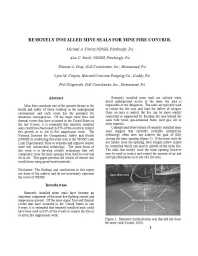Mining Publication: Remotely Installed Mine Seals for Mine Fire Control
Original creation date: March 2006
Mine fires are one of the greatest threats to the health and safety of underground workers. Each event has the potential for disastrous consequences. Of the major mine fires and thermal events that have occurred in the United States in the last 6 years, it is estimated that remotely installed seals could have been used in 63% of the events to control fire growth or to aid in fire suppression. NIOSH is conducting full-scale tests at its Lake Lynn Experimental Mine to evaluate and improve remote mine seal construction technology. The main focus of this work is to develop reliable technology that will completely close the mine opening from floor to roof and from rib to rib. This paper presents the results of remote seal installations using grout-based materials.
Authors: MA Trevits, AC Smith, TA Gray, LM Crayne, P Glogowski
Conference Paper - March 2006
NIOSHTIC2 Number: 20029938
2006 SME Annual Meeting and Exhibit, March 27-29, St. Louis, Missouri, preprint 06-70. Littleton, CO: Society for Mining, Metallurgy, and Exploration, Inc., 2006 Mar; :1-10
See Also
- Demonstration of Remote Mine Seal Construction
- Evaluation of the Bagged Stone Dust Barrier Effectiveness in a Bord and Pillar Mine
- Initial Study of Buried Communication Cable for Underground Mines
- Progress Toward Improved Engineering of Seals and Sealed Areas of Coal Mines
- Reducing the Fire and Explosion Hazards of Flame-Cutting and Welding in Underground Coal Mines
- Refuge Chamber Expectations Training - 1.0
- Rock Dusting Considerations in Underground Coal Mines
- Smoke, Carbon Monoxide, and Hydrogen Chloride Production from the Pyrolysis of Conveyor Belting and Brattice Cloth
- Technology News 535 - NIOSH Releases New Educational Video: Escape from Farmington No. 9: An Oral History
- U.S. Bureau of Mines Technology Applicable to Disaster Response, Urban Search And Rescue
- Page last reviewed: 9/21/2012
- Page last updated: 9/21/2012
- Content source: National Institute for Occupational Safety and Health, Mining Program


 ShareCompartir
ShareCompartir
